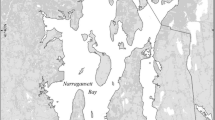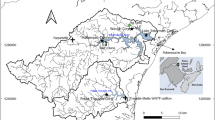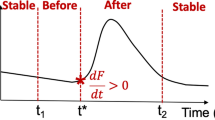Abstract
Three sequential hurricanes in the fall of 1999 provided the impetus for assessing multi-annual effects on water quality and phytoplankton dynamics in southwestern Pamlico Sound, North Carolina. Two and a half years of post-hurricane data were examined for short- and long-term impacts from the storms and >100 year flooding. Salinity decreased dramatically and did not recover until May 2000. Inorganic nitrogen and phosphorus concentrations were briefly elevated during the flooding, but later returned to background levels. Dissolved organic carbon concentrations declined through the whole study period, but did not appear to peak as was observed in the Neuse River estuary, a key tributary of the Sound. Light attenuation was highest in the fall to spring following the storms and was best correlated with chlorophylla concentrations. Phytoplankton biomass (chla) increased and remained elevated until late spring 2000 when concentrations returned to pre-storm levels and then cycled seasonally. Phytoplankton community composition varied throughout the study, reflecting the complex interaction between physiological optimal and combinations of salinity, residence time, nutrient availability, and possibly grazing activity. Floodwater advection or dilution from upstream maxima may have controlled the spatial heterogeneity in total and group-specific biomass. The storms produced areas of shortterm hypoxia, but hypoxic events continued during the following two summers, correlating strongly with water column stratification. Nitrogen loading to the southwestern sound was inferred from network analysis of previous nitrogen cycling studies in the Neuse River estuary. Based on these analyses, nutrient cycling and removal in the sub-estuaries would be decreased under high flow conditions, confirming observations from other estuaries. The inferred nitrogen load from the flood was 2–3 times the normal loading to the Sound; this estimate was supported by the substantial algal bloom. After 8-mos, the salinity and chla data indicated the Sound had returned to pre-hurricane conditions, yet phytoplankton community compositional changes continued through the multi-year study period. This is an example of long-term aspects of estuarine recovery that should be considered in the context of a predicted 10–40 yr period of elevated tropical storm activity in the western Atlantic Basin.
Similar content being viewed by others
Literature Cited
Arar, E. J., W. L. Budde, andT. D. Behymer. 1997. Methods for the determination of chemical substances in marine and environmental matrices. EPA/600/R-97/072. National Exposure Research Laboratory, U.S. Environmental Protection Agency, Cincinnati, Ohio.
Bales, J. D. 2003. Effects of Hurricane Floyd inland flooding, September–October 1999, on tributaries to Pamlico Sound, North Carolina.Estuaries 26:1319–1328.
Bales, J. D., C. J. Oblinger, andA. H. Sallenger, Jr. 2000. Two months of flooding in eastern North Carolina, September–October 1999. Water-Resources Investigations Report 00-4093. U.S. Geological Survey, Raleigh, North Carolina.
Balls, P. W. 1994. Nutrient inputs to estuaries from nine Scottish east coast rivers; influence of estuarine processes on inputs to the North Sea.Estuarine, Coastal and Shelf Science 39: 329–352.
Boyer, J. N., R. R. Christian, andD. W. Stanley. 1993. Patterns of phytoplankton primary productivity in the Neuse River estuary, North Carolina, USA.Marine Ecology Progress Series 97: 287–297.
Boyer, J. N., D. W. Stanley, andR. R. Christian. 1994. Dynamics of NH4+ and NO3− uptake in the water column of the Neuse River estuary, North Carolina.Estuaries 17:361–371.
Buzzelli, C. P., R. A. Luettich, Jr.,S. P. Powers, C. H. Peterson, J. E. McNinch, J. L. Pinckney, andH. W. Paerl. 2002. Estimating the spatial extent of bottom-water hypoxia and habitat degradation in a shallow estuary.Marine Ecology Progress Series 230:103–112.
Buzzelli, C. P., J. S. Ramus, andH. W. Paerl. 2003. Ferry-Based Monitoring of Surface Water Quality in North Carolina Estuaries.Estuaries 26:975–984.
Chan, T. U. andD. P. Hamilton. 2001. Effect of freshwater flow on the succession and biomass of phytoplankton in a seasonal estuary.Marine and Freshwater Research 52:869–884.
Chesapeake Research Consortium. 1976. The Effects of Tropical Storm Agnes on the Chesapeake Bay Estuarine System. The Johns Hopkins University Press, Baltimore, Maryland.
Christian, R. R., J. N. Boyer, andD. W. Stanley. 1991. Multiyear distribution patterns of nutrients within the Neuse River estuary, North Carolina.Marine Ecology Progress Series 71:259–274.
Christian, R. R., J. N. Boyer, D. W. Stanley, andW. M. Rizzo. 1992. Network analysis of nitrogen cycling in an estuary, p. 217–247.In C. Hurst (ed.). Modeling the Metabolic and Physiologic Activities of Microorganisms. Wiley, New York.
Christian, R. R., D. W. Stanley, andD. A. Daniel. 1984. Microbiological changes occurring at the freshwater-seawater interface of the Neuse River estuary, North Carolina, p. 349–365.In V. S. Kennedy (ed.). The Estuary as a Filter. Academic Press, New York.
Christian, R. R. andC. R. Thomas. 2000. Neuse River estuary modeling and monitoring project stage 1: Network analysis for evaluating the consequences of nitrogen loading. Water Resources Research Institute Report No. 325-F. Water Resources Research Institute, University of North Carolina, Raleigh, North Carolina.
Christian, R. R. andC. R. Thomas. 2003. Network analysis of nitrogen inputs and cycling in the Neuse River estuary, North Carolina, USA.Estuaries 26:815–828.
Cloern, J. E. 1996. Phytoplankton bloom dynamics in coastal ecosystems: A review with some general lessons from sustained investigations of San Francisco Bay, California.Reviews of Geophysics 34:127–168.
Collos, Y. 1986. Time-lag alga growth dynamics: Biological constraints on primary production in aquatic environments.Marine Ecology Progress Series 33:193–206.
Costanza, R., W. M. Kemp, andW. R. Boynton. 1993. Predictability, scale and biodiversity in coastal and estuarine ecosystems: Implication for management.Ambio 22:88–96.
Day, Jr.,J. W., C. A. S. Hall, W. M. Kemp, andA. Yańez-Arancibia. 1989. Estuarine Ecology. John Wiley and Sons, New York.
Epperly, S. P. andS. W. Ross. 1986. Characterization of the North Carolina Pamlico-Albemarle estuarine complex. NOAA Technical Memorandum NMFS-SEFC-175. National Oceanographic and Atmospheric Administration, Beaufort, North Carolina.
Eyre, B. D. 2000. Regional evaluation of nutrient transformation and phytoplankton growth in nine river-dominated sub-tropical east Australian estuaries.Marine Ecology Progress Series 205: 61–83.
Eyre, B. andP. Balls. 1999. A comparative study of nutrient behavior along the salinity gradient of tropical and temperature estuaries.Estuaries 22:313–326.
Eyre, B. andC. Twigg. 1997. Nutrient behavior during post-flood recovery of the Richmond River estuary northern NSW, Australia.Estuarine, Coastal and Shelf Science 44:311–326.
Giese, G. L., H. B. Wilder, andG. G. Parker, Jr. 1985. Hydrology of major estuaries and sounds of North Carolina. U.S. Geological Survey Water-Supply Paper 2221. U.S. Geological Survey, Alexandria, Virginia.
Goldenberg, S. B., C. W. Landsea, A. M. Mestas-Nuńez, andW. M. Gray. 2001. The recent increase in Atlantic hurricane activity: Causes and implications.Science 293:474–479.
Jeffrey, S. W. andG. F. Humphrey. 1975. New spectrophotometric equations for determining chlorophyllsa, b, c1 andc2 in higher plants, algae and natural phytoplankton.Biochemie und Physiologie der Pflanzen 167:191–194.
Jeffrey, S. W., R. F. C. Mantoura, andS. W. Wright. 1997. Phytoplankton Pigments in Oceanography: Guidelines to Modern Methods. UNESCO Publishing, Paris, France.
Kristiansen, S. 1998. Impact of increased river discharge on the phytoplankton community in the outer Oslofjord, Norway.Hydrobiologia 363:169–177.
Lackey, G. J. 1992. The effects of light and nutrient availability on primary productivity across the freshwater-saltwater interface of the Neuse River estuary, North Carolina. M.S. Thesis, East Carolina University, Greenville, North Carolina.
Litaker, R. W., P. A. Tester, C. S. Duke, B. E. Kenney, J. L. Pinckney, andJ. S. Ramus. 2002. Seasonal niche strategy of the bloom-forming dinoflagellateHeterocapsa triquetra.Marine Ecology Progress Series 232:45–62.
Luettich, Jr.,R. A., J. E. McNinch, H. W. Paerl, C. H. Peterson, J. T. Wells, M. Alperin, C. S. Martens, andJ. L. Pinckney. 2000. Neuse River Estuary modeling and monitoring project stage 1: Hydrography and circulation, water column nutrients and productivity, sedimentary processes and benthic-pelagic coupling, and benthic ecology. Report No. 325-B. Water Resources Research Institute, University of North Carolina. Raleigh, North Carolina.
Mackey, M. D., D. J. Mackey, H. W. Higgins, andS. W. Wright. 1996. CHEMTAX—A program for estimating class abundances from chemical markers: Application to HPLC measurements of phytoplankton.Marine Ecology Progress Series 144:265–283.
Mallin, M. A., M. H. Posey, M. R. McIver, D. C. Parsons, S. H. Ensign, andT. D. Alphin. 2002. Impacts and recovery from multiple hurricanes in a Piedmont-coastal plain river system.Bioscience 52:999–1010.
Mallin, M. A., M. H. Posey, G. C. Shank, M. R. McIver, S. H. Ensign, andT. D. Alphin. 1999. Hurricane effects on water quality and benthos in the Cape Fear watershed: Natural and anthropogenic impacts.Ecological Applications 9:350–362.
McKee, L. J., B. D. Eyre, andS. Hossain 2000. Transport and retention of nitrogen and phosphorus in the sub-tropical Richmond River estuary, Australia—A budget approach.Biogeochemistry 50:241–278.
Mitchell, A. W., R. G. V. Bramley, andA. K. L. Johnson. 1997. Export of nutrients and suspended sediment during a cyclone-mediated flood event in the Herbert River catchment, Australia.Marine and Freshwater Research 48:79–88.
Nixon, S. W. 1995. Coastal marine eutrophication: A definition, social causes, and future concerns.Ophelia 41:199–219.
Nixon, S. W., J. W. Ammerman, L. P. Atkinson, V. M. Berounsky, G. Billen, W. C. Boicourt, W. R. Boynton, T. M. Church, D. M. DiToro, R. Elmgren, J. H. Garber, A. E. Giblin, R. A. Jahnke, N. J. P. Owens, M. E. Q. Pilson, andS. P. Seitzinger. 1996. The fate of nitrogen and phosphorus at the land-sea margin of the North Atlantic Ocean.Biogeochemistry 35:141–180.
Paerl, H. W. 1988. Nuisance phytoplankton blooms in coastal, estuarine, and inland waters.Limnology and Oceanography 33: 823–847.
Paerl, H. W. 1999. Physical-chemical constraints on cyanobacterial growth in the oceans, p. 319–349.In L. Charpy and A. W. D. Larkum (eds.), Marine Cyanobacteria. Musee Océanographique, Monaco.
Paerl, H. W., J. D. Bales, L. W. Ausley, C. P. Buzzelli, L. B. Crowder, L. A. Eby, J. M. Fear, M. Go, B. L. Peieris, T. L. Richardson, andJ. S. Ramus. 2001. Ecosystem impacts of three sequential hurricanes (Dennis, Floyd, and Irene) on the United States' largest lagoonal estuary, Pamlico Sound, NC.Proceedings of the National Academy of Sciences of the United States of America 98:5655–5660.
Paerl, H. W., J. L. Pinckney, J. M. Fear, andB. L. Peierls. 1998. Ecosystem responses to internal and watershed organic matter loading: Consequences for hypoxia in the eutrophying Neuse River estuary, North Carolina, USA.Marine Ecology Progress Series 166:17–25.
Pietrafesa, L. J., G. S. Janowitz, T.-Y. Chao, R. H. Weisberg, F. Askari, andE. Noble. 1986. The physical oceanography of Pamlico Sound. Sea Grant Publication UNC-WP-86-5. University of North Carolina Sea Grant, Raleight, North Carolina.
Pinckney, J. L., D. F. Millie, K. E. Howe, H. W. Paerl, andJ. P. Hurley. 1996. Flow scintillation counting of14C-labeled microalgal photosynthetic pigments.Journal of Plankton Research 18:1867–1880.
Pinckney, J. L., H. W. Paerl, andM. B. Harrington, 1999. Responses of the phytoplankton community growth rate to nutrient pulses in variable estuarine environments.Journal of Phycology 35:1455–1463.
Pinckney, J. L., H. W. Paerl, M. B. Harrington, andK. E. Howe. 1998. Annual cycles of phytoplankton community-structure and bloom dynamics in the Neuse River estuary, North Carolina.Marina Biology 131:371–381.
Pinckney, J. L., T. L. Richardson, D. F. Millie, andH. W. Paerl. 2001. Application of photopigment biomarkers for quantifying microalgal community composition and in situ growth rates.Organic Geochemistry 32:585–595.
Ramus, J. S., L. A. Eby, C. M. McClellian, andL. B. Crowder. 2003. Phytoplankton forcing by a record freshwater discharge event into a large lagoonal estuary.Estuaries 26:1344–1352.
Rizzo, W. M. andR. R. Christian. 1996. Significance of subtidal sediments to heterotrophically-mediated oxygen and nutrient dynamics in a temperature estuary.Estuaries 19:475–487.
Rizzo, W. M., G. J. Lackey, andR. R. Christian. 1992. Significance of euphotic, subtidal sediments to oxygen and nutrient cycling in a temperate estuary.Marine Ecology Progress Series 86: 51–61.
Rudek, J., H. W. Paerl, M. A. Mallin, andP. W. Bates. 1991. Seasonal and hydrological control of phytoplankton nutrient limitation in the lower Neuse River estuary, North Carolina.Marine Ecology Progress Series 75:133–142.
Sharp, J. H., J. R. Pennock, T. M. Church, J. M. Tramontano, andL. A. Cifuentes. 1984. The estuarine interaction of nutrients, organics, and metals: A case study in the Delaware estuary, p. 241–258.In V. S. Kennedy (ed.). The Estuary as a Filter. Academic Press, New York.
Shiah, P.-K., S.-W. Chung, S.-J. Kao, G.-C. Gong, andK.-K. Liu. 2000. Biological and hydrographical responses to tropical cyclones (typhoons) in the continental shelf of the Taiwan Strait.Continental Shelf Research 20:2029–2044.
Steel, J. 1991. Albemarle-Pamlico estuarine system: technical analysis of status and trends. Albemarle-Pamlico Estuarine Study Report No. 91-01. North Carolina Department of Environment, Health, and Natural Resources, Raleigh, North Carolina.
Steemann Nielsen, E. 1952. The use of radio-active carbon (C14) for measuring organic production in the sea.Journal du Conseil permanent international pour L'Exploration de la Mer 18: 117–140.
Tabb, D. C. andA. C. Jones. 1962. Effect of Hurricane Donna on the aquatic fauna of north Florida Bay.Transaction of the American Fisheries Society 91:375–378.
Tester, P. A., S. M. Varnam, M. Culver, D. L. Eslinger, R. P. Stumpf, J. Hare, R. Swift, J. Jungle, andR. W. Litaker. 2003. Airborne detection of ecosystem responses to an extreme event: Phytoplankton displacement and abundance after hurricane induced flooding in the Pamlico Albemarle Sound System, North Carolina.Estuaries 26:1353–1364.
U.S. Environmental Protection Agency. 2000. Ambient aquatic life water quality criteria for dissolved oxygen (saltwater): Cape Cod to Cape Hatteras, EPA-822-R-00-012. U.S. Environmental Protection Agency, Washington, D.C.
Ulanowicz, R. E. 1987. NETWRK4: A Package of Computer Algorithms to Analyze Ecological Flow Networks. University of Maryland, Chesapeake Biological Laboratory, Solomons, Maryland.
Valiela, I., P. Peckol, C. D'Avanzo, J. Kremer, D. Hersh, K. Foreman, K. Lajtha, B. Seely, W. R. Geyer, T. Isaji, andR. Crawford. 1998. Ecological effects of major storms on coastal watersheds and coastal waters: Hurricane Bob on Cape Cod.Journal of Coastal Research 14:218–238.
Van Dolah, R. F. andG. S. Anderson. 1991. Effects of Hurricane Hugo on salinity and dissolved oxygen conditions in the Charleston Harbor estuary, p. 83–94.In C. W. Finkl and O. H. Pilkey (eds.). Impacts of Hurricane Hugo: September 10–22, 1989. Coastal Education and Research Foundation, Fort Lauderdale, Florida.
Williams, A. B., G. S. Posner, W. J. Woods, andE. E. Deubler, Jr. 1973. A hydrographic atlas of larger North Carolina sounds. Sea Grant Publication UNC-SG-73-02. University of North Carolina Sea Grant Program, Chapel Hill, North Carolina.
Woods, W. J. 1967. Hydrographic studies in Pamlico Sound, p. 105–114.In Proceedings of Symposium on Hydrology of the Coastal Waters of North Carolina. Water Resources Research Institute, University of North Carolina, Raleigh, North Carolina.
Sources of Unpublished Materials
Crowder, L. Personal Communication. Duke University Marine Laboratory, 135 Duke Marine Lab Road, Beaufort, North Carolina 28516.
Kleppel, G. Personal Communication. Department of Biological Sciences, State University of New York at Albany, 1400 Washington Avenue, Albany, New York 12222.
Author information
Authors and Affiliations
Corresponding author
Rights and permissions
About this article
Cite this article
Peierls, B.L., Christian, R.R. & Paerl, H.W. Water quality and phytoplankton as indicators of hurricane impacts on a large estuarine ecosystem. Estuaries 26, 1329–1343 (2003). https://doi.org/10.1007/BF02803635
Received:
Revised:
Accepted:
Issue Date:
DOI: https://doi.org/10.1007/BF02803635




